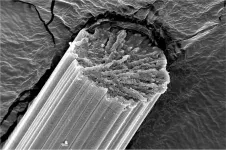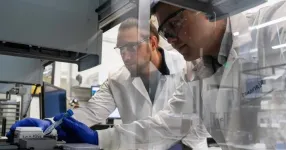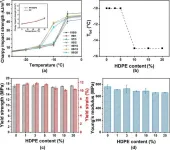(Press-News.org) When spiders spin their webs, they use their hind legs to pull silk threads from their spinnerets. This pulling action doesn’t just help the spider release the silk, it’s also a crucial step in strengthening the silk fibers for a more durable web.
In a new study, Northwestern University researchers have discovered why the role of stretching is so important. By simulating spider silk in a computational model, the team discovered the stretching process aligns the protein chains within the fibers and increases the number of bonds between those chains. Both factors lead to stronger, tougher fibers.
The team then validated these computational predictions through laboratory experiments using engineered spider silk. These insights could help researchers design engineered silk-inspired proteins and spinning processes for various applications, including strong, biodegradable sutures and tough, high-performance, blast-proof body armor.
The study will be published on Friday (March 7) in the journal Science Advances.
“Researchers already knew this stretching, or drawing, is necessary for making really strong fibers,” said Northwestern’s Sinan Keten, the study’s senior author. “But no one necessarily knew why. With our computational method, we were able to probe what’s happening at the nanoscale to gain insights that cannot be seen experimentally. We could examine how drawing relates to the silk’s mechanical properties.”
“Spiders perform the drawing process naturally,” said Northwestern Jacob Graham, the study’s first author. “When they spin silk out of their silk gland, spiders use their hind legs to grab the fiber and pull it out. That stretches the fiber as it’s being formed. It makes the fiber very strong and very elastic. We found that you can modify the fiber’s mechanical properties simply through modifying the amount of stretching.”
An expert in bioinspired materials, Keten is the Jerome B. Cohen Professor of Engineering, professor and associate chair of mechanical engineering and professor of civil and environmental engineering at Northwestern’s McCormick School of Engineering. Graham is a Ph.D. student in Keten’s research group.
Stronger than steel, tougher than Kevlar
Researchers long have been interested in spider silk because of its remarkable properties. It’s stronger than steel, tougher than Kevlar and stretchy like rubber. But farming spiders for their natural silk is expensive, energy-intensive and difficult. So, scientists instead want to recreate silk-like materials in the lab.
“Spider silk is the strongest organic fiber,” Graham said. “It also has the advantage of being biodegradable. So, it’s an ideal material for medical applications. It could be used for surgical sutures and adhesive gels for wound-closure because it would naturally, harmlessly degrade in the body.”
Study coauthor Fuzhong Zhang, the Francis F. Ahmann Professor at Washington University (WashU) in St. Louis, has been engineering microbes to produce spider-silk materials for several years. By extruding engineered spider silk proteins and then stretching them by hand, the team has developed artificial fibers similar to threads from the golden silk orb weaver, a large spider with a spectacularly strong web.
Simulating stretchiness
Despite developing this “recipe” for spider silk, researchers still don’t fully understand how the spinning process changes fiber structure and strength. To tackle this open-ended question, Keten and Graham developed a computational model to simulate the molecular dynamics within Zhang’s artificial silk.
Through these simulations, the Northwestern team explored how stretching effects the proteins’ arrangement within the fibers. Specifically, they looked at how stretching changes the order of proteins, the connection of proteins to one another and the movement of molecules within the fibers.
Keten and Graham found that stretching caused the proteins to “line up,” which increased the fiber’s overall strength. They also found that stretching increased the number of hydrogen bonds, which act like bridges between the protein chains to make up the fiber. The increase in hydrogen bonds contributes to the fiber’s overall strength, toughness and elasticity, the researchers found.
“Once a fiber is extruded, its mechanical properties are actually quite weak,” Graham said. “But when it’s stretch up to six times its initial length, it becomes very strong.”
Experimental validation
To validate their computational findings, the team used spectroscopy techniques to examine how the protein chains stretched and aligned in real fibers from the WashU team. They also used tensile testing to see how much stretching the fibers could tolerate before breaking. The experimental results agreed with the simulation’s predictions.
“If you don’t stretch the material, you have these spherical globs of proteins,” Graham said. “But stretching turns these globs into more of an interconnected network. The protein chains stack on top of one another, and the network becomes more and more interconnected. Bundled proteins have more potential to unravel and extend further before the fiber breaks, but initially extended proteins make for less extensible fibers that require more force to break.”
Although Graham used to think spiders were just creepy-crawlies, he now sees their potential to help solve real problems. He notes that engineered spider silk provides a stronger, biodegradable alternative to other synthetic materials, which are mostly petroleum-derived plastics.
“I definitely look at spiders in a new light,” Graham said. “I used to think they were nuisances. Now, I see them as a source of fascination.”
The study, “Charting the envelope of mechanical properties of synthetic silk fibers through predictive modeling of the drawing process,” was supported by the National Science Foundation (grant numbers OIA-2219142 and DMR-2207879).
END
Stretching spider silk makes it stronger
New study finds the amount of stretching determines the fibers’ properties
2025-03-07
ELSE PRESS RELEASES FROM THIS DATE:
Earth's orbital rhythms link timing of giant eruptions and climate change
2025-03-07
On ten thousand to million years time scales, climate dynamics on the Earth’s surface are driven by both external and internal processes. Earth`s interior provides heat from radioactive decay and chemical compounds by volcanic degassing, such as sulfur dioxide (SO2) and carbon dioxide (CO2). Quasiperiodic changes in Earth’s orbit around the sun regulate the amount of incoming solar radiation on the planet’s surface as well as its distribution across latitudes, affecting the length and intensity ...
Ammonia build-up kills liver cells but can be prevented using existing drug
2025-03-07
High levels of ammonia kill liver cells by damaging the mitochondria that power the cells. But this can be prevented using an existing drug due to start clinical trials, finds a new study in mice led by researchers from UCL.
The study, published in Science Advances, is the first to observe that build-up of ammonia (hyperammonaemia) can harm liver cells and describe how this damage occurs in mouse models that are clinically relevant for humans.
Hyperammonaemia is known to cause brain dysfunction in those with liver disease, ...
New technical guidelines pave the way for widespread adoption of methane-reducing feed additives in dairy and livestock
2025-03-07
Philadelphia, March 7, 2025 – After many decades of research, the dairy sector has a significant body of peer-reviewed research showing that feed additives can effectively reduce methane, the greenhouse gas that makes up most of dairy’s environmental footprint. Yet the practical use of this knowledge on farms—as well as general awareness around additive effectiveness and safety—is still gaining momentum. At this critical point in the dairy sector’s pathway to a net-zero future, the Journal of Dairy Science, the leading general dairy research journal from ...
Eradivir announces Phase 2 human challenge study of EV25 in healthy adults infected with influenza
2025-03-07
WEST LAFAYETTE, Ind. — Eradivir, a clinical-stage small molecule immunotherapy biotech company, announced it has begun a Phase 2 challenge study with its antiviral therapeutic, EV25. The study will provide safety and efficacy data gathered from otherwise healthy participants infected with influenza then later treated with EV25.
EV25 was built on a platform created in Philip Low’s lab. Low is the Presidential Scholar for Drug Discovery and the Ralph C. Corley Distinguished Professor of Chemistry in Purdue University’s College of Science. Low is Eradivir’s chief scientific officer and on its board of directors.
The European Medicines ...
New study finds that tooth size in Otaria byronia reflects historical shifts in population abundance
2025-03-07
Puerto Madryn, Argentina – A new study published in PeerJ Life and Environment reveals that the teeth of South American sea lions (Otaria byronia) hold valuable clues about past population dynamics. Researchers from the Instituto de Biología de Organismos Marinos, the Centro para el Estudio de Sistemas Marinos, and the Universidad Nacional de la Patagonia San Juan Bosco analysed changes intooth size and growth layer groups (GLGs) over the ...
nTIDE March 2025 Jobs Report: Employment rate for people with disabilities holds steady at new plateau, despite February dip
2025-03-07
East Hanover, NJ – March 7, 2024 – The employment rate for people with disabilities saw a slight dip in February but continued to fluctuate around a steady plateau of approximately 37.5%. While these dips can trigger speculation about broader policy implications, nTIDE experts cautioned that it is premature to attribute changes to recent shifts in federal employment policies. The employment-to-population ratio for people with disabilities remained stable. nTIDE is issued by Kessler Foundation and the ...
Breakthrough cardiac regeneration research offers hope for the treatment of ischemic heart failure
2025-03-07
Researchers in the Michael E. DeBakey Department of Surgery at Baylor College of Medicine, the QIMR Berghofer Medical Research Institute in Brisbane, Australia, and collaborating institutions report a groundbreaking discovery in cardiac regeneration that offers new hope for the treatment of ischemic heart failure. Published in npj Regenerative Medicine, the study reveals a novel approach to promoting cardiomyocyte proliferation.
“When the heart cannot replace injured cardiomyocytes with healthy ones, it becomes progressively ...
Fluoride in drinking water is associated with impaired childhood cognition
2025-03-07
Elevated concentrations of fluoride can occur in well water, and in some countries, it is added to drinking water to counteract caries in the population. A study from Karolinska Institutet in Sweden now supports a few previous studies indicating that exposure to fluoride during the fetal stage or early childhood may impair cognition in children. The study is published in the journal Environmental Health Perspectives.
Fluoride occurs naturally as fluoride ions in drinking water, but the concentrations are generally low in ...
New composite structure boosts polypropylene’s low-temperature toughness
2025-03-07
A recent study published in Engineering presents a significant advancement in improving the toughness of polypropylene (PP), a widely used thermoplastic material. The research, led by Zhiyi Zhang and Qiang Zheng from Taiyuan University of Technology and Zhejiang University, focuses on developing a novel core–shell structured composite to enhance PP’s performance at low temperatures.
PP has many advantages, such as high thermal and chemical resistance, but its low-temperature toughness is a limiting ...
While most Americans strongly support civics education in schools, partisan divide on DEI policies and free speech on college campuses remains
2025-03-07
A new report looking at adults’ views on education topics shows more partisan agreement about how to educate students for citizenship than many might think, yet sharp partisan divide around issues of diversity, equity and inclusion policies on college campuses and free speech.
The report, published by the USC Center for Applied Research in Education, a center housed within USC Dornsife’s Center for Economic and Social Research, in partnership with the USC EdPolicy Hub, is based on a nationally representative, probability-based ...
LAST 30 PRESS RELEASES:
What causes some people’s gut microbes to produce high alcohol levels?
Global study reveals widespread burning of plastic for heating and cooking
MIT study shows pills that communicate from the stomach could improve medication adherence
Searching for the centromere: diversity in pathways key for cell division
Behind nature’s blueprints
Researchers search for why some people’s gut microbes produce high alcohol levels
Researchers find promising new way to boost the immune response to cancer
Coffee as a staining agent substitute in electron microscopy
Revealing the diversity of olfactory receptors in hagfish and its implications for early vertebrate evolution
Development of an ultrasonic sensor capable of cuffless, non-invasive blood pressure measurement
Longer treatment with medications for opioid use disorder is associated with greater probability of survival
Strategy over morality can help conservation campaigns reduce ivory demand, research shows
Rising temperatures reshape microbial carbon cycling during animal carcass decomposition in water
Achieving ultra-low-power explosive jumps via locust bio-hybrid muscle actuators
Plant-derived phenolic acids revive the power of tetracycline against drug-resistant bacteria
Cooperation: A costly affair in bacterial social behaviour?
Viruses in wastewater: Silent drivers of pollution removal and antibiotic resistance
Sub-iethal water disinfection may accelerate the spread of antibiotic resistance
Three in four new Australian moms struggle with body image
Post-stroke injection protects the brain in preclinical study
Cardiovascular risk score predicts multiple eye diseases
Health: estimated one in ten British adults used or interested in GLP-1 medications for weight loss
Exercise to treat depression yields similar results to therapy
Whooping cough vaccination for pregnant women strengthens babies’ immune system
Dramatic decline in new cases of orphanhood in Uganda driven by HIV treatment and prevention programs
Stopping weight loss drugs linked to weight regain and reversal of heart health markers
Higher intake of food preservatives linked to increased cancer risk
Mass General Brigham–developed cholera vaccine completes phase 1 trial
First experimental validation of a “150-year-old chemical common sense” direct visualization of the molecular structural changes in the ultrafast anthracene [4+4] photocycloaddition reaction
Lack of support for people on weight loss drugs leaves them vulnerable to nutritional deficiencies, say experts
[Press-News.org] Stretching spider silk makes it strongerNew study finds the amount of stretching determines the fibers’ properties





